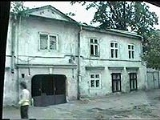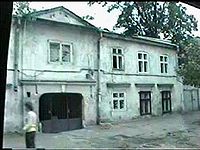
Moldavanka
Encyclopedia

Odessa
Odessa or Odesa is the administrative center of the Odessa Oblast located in southern Ukraine. The city is a major seaport located on the northwest shore of the Black Sea and the fourth largest city in Ukraine with a population of 1,029,000 .The predecessor of Odessa, a small Tatar settlement,...
in the Odessa Oblast
Odessa Oblast
Odesa Oblast, also written as Odessa Oblast , is the southernmost and largest oblast of south-western Ukraine. The administrative center of the oblast is the city of Odessa.-History:...
(province
Oblast
Oblast is a type of administrative division in Slavic countries, including some countries of the former Soviet Union. The word "oblast" is a loanword in English, but it is nevertheless often translated as "area", "zone", "province", or "region"...
) of southern Ukraine
Ukraine
Ukraine is a country in Eastern Europe. It has an area of 603,628 km², making it the second largest contiguous country on the European continent, after Russia...
, located jointly on Malinovskiy and Primorskiy city districts. Before 1820 a settlement just outside of Odessa which later engulfed it. Until the 20th century the neighborhood was considered a low-income/high-crime part of the town and was famous for its workers' shacks.
Historical overview
The city of Odessa was officially founded in 1794 as an Imperial Russian naval fortress on the ruins of a former OttomanOttoman Empire
The Ottoman EmpireIt was usually referred to as the "Ottoman Empire", the "Turkish Empire", the "Ottoman Caliphate" or more commonly "Turkey" by its contemporaries...
fortress named Khadjibey (or Kotsyubiiv). By January 1795, the new name was mentioned for the first time in official correspondence.
However, adjacent to the new official locality, a certain Moldovan
Moldovans
Moldovans or Moldavians are the largest population group of Moldova...
colony had already existed, which by the end of 18th century was an independent settlement known under the name of Moldavanka. Legend has it that the settlement predates Odessa by about thirty years and asserts that the locality was founded by Romanians
Romanians
The Romanians are an ethnic group native to Romania, who speak Romanian; they are the majority inhabitants of Romania....
who came to build the fortress of Yeni Dunia for the Ottomans and eventually settled in the area in the late 1760s, right next to the settlement of Khadjibey (since 1795 Odessa proper), on what later became the Primorskii Boulevard.
The Romanians owned relatively small plots on which they built village style houses and cultivated vineyards and gardens. What was to become Mikhailiv Square was the center of this settlement and the site of its first Orthodox church, the Church of the Dormition, built in 1821 close to the sea shore, as well as of a cemetery. Nearby were the military barracks and the country houses (dacha
Dacha
Dacha is a Russian word for seasonal or year-round second homes often located in the exurbs of Soviet and post-Soviet cities. Cottages or shacks serving as family's main or only home are not considered dachas, although many purpose-built dachas are recently being converted for year-round residence...
) of the city's wealthy residents, including that of the Duc de Richelieu
Armand-Emmanuel du Plessis, Duc de Richelieu
Armand Emmanuel Sophie Septimanie de Vignerot du Plessis, 5th Duke of Richelieu was a prominent French statesman during the Bourbon Restoration...
, appointed by Czar Alexande I
Alexander I of Russia
Alexander I of Russia , served as Emperor of Russia from 23 March 1801 to 1 December 1825 and the first Russian King of Poland from 1815 to 1825. He was also the first Russian Grand Duke of Finland and Lithuania....
as Governor of Odessa in 1803.
In the period from 1795 to 1814 the population of Odessa had increased 15 times and reached almost 20 thousand people. Colonists of various ethnicities settled mainly in the area of former Romanian colony, outside of the official boundaries, and as a consequence, in the first third of the 19th century, Moldavanka emerged as the dominant settlement.
After planning by the official architects who designed buildings in Odessa's central district, such as the Italians Franz Karlowicz Boffo and Giovanni Torichelli, Moldovanka was included in the general city plan, though the original grid-like plan of Moldovankan streets, lanes and squares remained unchanged.
- It looked like an industrial backyard of Odessa, where the plants and factories were located. The residents of this neighborhood were mostly the people who worked in those factories.
- Even in nowadays, Moldavanka's setting is mostly industrial. However, since some of the plants and factories are out of business today, they are demolished and high-rise living quarters and business centers take their places.
Prior to the Bolshevik Revolution of 1917, Moldavanka was the center of the city's Orthodox Jewish quarter. It is also the setting of the stories in The Odessa Tales
The Odessa Tales
The Odessa Tales is a collection of short stories by Isaac Babel, situated in Odessa in the last days of the Russian empire and the Russian Revolution. Published individually in magazines throughout 1923 and 1924 and collected into a book in 1931, they deal primarily with a group of Jewish thugs...
and the play Sunset
Sunset (play)
The play Sunset was written by Isaac Babel in 1926 and based on his short story collection The Odessa Tales.-Plot:The play is sent in Moldavanka, Odessa's Jewish Quarter in 1913...
, both by Isaak Babel. The neighborhood also is mentioned by the Russian jazz song containing the slight local accent and performed by Mark Bernes
Mark Bernes
Mark Naumovich Bernes was a Soviet actor and singer of Jewish ancestry , who performed some of the most poignant songs to come out of the World War II, including Tyomnaya noch and Zhuravli...
"Chalands, that filled with mugil
Mugil
Mugil is one genus among 17 genera containing all together about 80 species of ray-finned fish of the family Mugilidae commonly known as mullet...
". (example available at youtube, footage of Dva boitsa film (Two Warriors))
Location
Moldavanka is located where the route - (Dalnytsia Street) intersects the route (Balkiv Street), in the vicinity of Mykhailiv Square. The better known route just north of it runs into the Rozumovsky Street heading towards the shoreline eastward.See also
- Mishka YaponchikMishka YaponchikMishka Yaponchik was a Odessa gangster, Jewish revolutionary, and Soviet military leader.-Early years:Born as Moisei Wolfovich Vinnitskiy to family of a Jewish wagon-builder Meer-Wolf Mordkoich Vinnitskiy by some records in stanitsa Golta , Mishka was around 4 years of age, Vinnitsky's family...
, one of the most notorious (if not the most notorious) residents of the Moldavanka's Jewish Quarter. - Benya KrikBenya KrikBenya Krik is a fictional Russian gangster of Jewish descent, whose gang of thugs is the main subject of Isaak Babel's collection of short stories The Odessa Tales. He also plays a prominent role in Babel's play Sunset...

